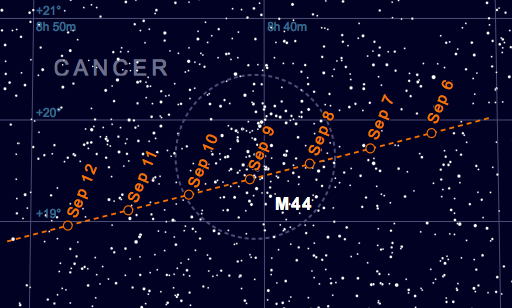
Mars buzzes the Beehive
BY MARK ARMSTRONG
ASTRONOMY NOW
Posted: 3 September 2013

Mars has to be the most maddening of all the planets! Mercury, and to a lesser extent Venus, can often be very shy, remaining frustratingly close to the Sun. Mars is a relatively small planet compared with Earth and Venus and displays a disappointing small disc through the eyepiece for long periods of time, as is the case at the moment.

AN graphic by Greg Smye-Rumsby
At unfavourable oppositions its apparent diameter can be no larger than 14 arcseconds. There is no opposition of the red planet this year as the average period when Martian opposition recur is a very long two years and 50 days. The next Mars opposition occurs in early April 2014. All in all Mars observers can have it tough.
This month Mars stubbornly refuses to brighten or grow substantially in size, shining at mag. +1.6 and remaining below the crucial five arcsecond apparent diameter barrier. But its saving grace at times like these can often be close encounters with the Moon, other planets and bright deep sky objects. This month Mars has a very close encounter in the pre-dawn sky with the marvellous Beehive or Praesepe open cluster (M44) in Cancer, an easy naked eye target with an integrated magnitude of +3.4; between 7th to 11th September Mars will actually cross over in front of M44.
Mars doesn't get higher than 20 degrees in the eastern morning sky by the start of nautical twilight (Sun between 6 and 12 degrees below the horizon) at 5am but this is sufficiently high to get a decent view if your local horizon is not blighted by trees or houses. My colleague Peter Grego says this event will be nice to view through any instrument that has a field of view large enough to encompass the whole cluster (apparent diameter 95 arcminutes) and Mars. Binocular will give fine views along with a small 'scope at x40 magnification or a super-wide angle eyepiece giving less than x60.
Praesepe has been known since classical times and is the Latin word for a 'crib' or 'manger' of the two donkeys rode by Dionysos and Silenus into battle against the Titan's and represented by the stars Asellus Borealis (gamma Cancri) and Asellus Australis (delta Cancri) north and south of M44. Hipparcos described the 'small cloud' and Galileo was the first to resolve it in 1609. Charles Messier added Praesepe to the first version of famous list published in 1774 (containing 45 objects), along with M42, M43 and M45 on the same night.
M44 is thought to lie 610 light years distant, making it one of the closest open clusters to our Solar System. Its apparent diameter of 95 arcminutes equates to an actual physical diameter of 22 light years in which more than 200 stars have been identified as members of the cluster, two dozen of which are brighter than magnitude +8. It's possible that M44 is much larger, maybe over 100 light years across with as many as 1000 members. Astronomers are in general agreement that M44 is around 600-700 million years old, matching that of the Hyades in Taurus; in fact it's thought they both evolved from the same diffuse, gaseous nebula.
Mars is closing in on a meeting with Comet 2012 S1 (ISON) and Regulus, luminary of Leo, later in September. Watch this space.
|



